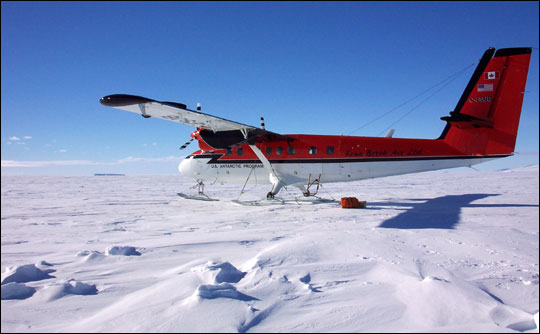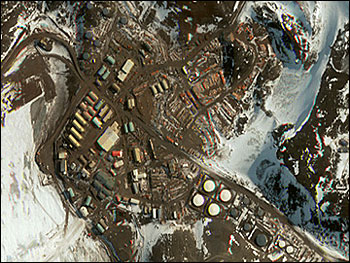

Winds and Flight Forecasts |
|||
A more immediate application of MODIS data is in observing polar winds. Jeff Key has already started to track winds over Antarctica based on cloud movement using MODIS. Better measurements of wind speed extend the accuracy of weather forecasts generated by forecasting models. Before they completed the ground station that lets them receive MODIS direct broadcast data in real time, Key had to wait for the satellite to reach North America to get the data it collected over Antarctica. Now, the station receives the data MODIS collects over Antarctica instantly, and that will let forecasters in Antarctica update their models more quickly. (To learn more about how MODIS improves weather forecasts, see "Polar Wind Data Blow New Life into Forecasts" on the Earth Observatory.) |
|||
 |
|||
“The station will have multiple benefits,” predicts Lazzara. The station is capable of receiving data from multiple sensors, including additional instruments on the Aqua satellite. “Forecasters don’t always get to see the latest and greatest, but in this case, they do.” Among the benefits of the new station, Cayette hopes that MODIS will help him predict more flight hazards like blowing snow and low clouds—something he has had some success with using data from the MODIS Rapid Response Website. Heading HomeThe stations supplied for the long winter, and the direct broadcast station installed and running, Stone and the others returned to the United States. They will spend the summer (North American summer, that is) making plans for the 2005-2006 research season, and those plans already include MODIS. |
A Twin Otter aircraft perches on the C-16 Iceberg. (Photo courtesy Shelley Knuth, AMRC/SSEC/UW-Madison, AWS/AMRC Photo Gallery) |
||

Three icebergs linger near McMurdo and the shipping track, and B-15A is about to move out of the Ross Sea. While MODIS will continue to be used to track their positions, Stone is already envisioning other applications. “In the early part of the season, we do a lot of work on the sea ice. MODIS will let us see what is going on with the ice,” says Stone. He will be looking for the edge of the ice and tracking large cracks to help plan safe locations for field camps. He hadn’t used satellite imagery extensively in the past because he hadn’t been able to access it easily. Now, reflects Stone, he asks for a MODIS image before planning anything. “MODIS got us addicted to daily imagery,” says Stone. “Expectations are different now. Now it’s easy. I love MODIS.” As for the weather team, Cayette sums up their MODIS plans. “We’re chomping at the bit to get down there and find out what we can do.”
|
Quickbird captured this image of McMurdo Station, the largest human community in the Antarctic. (Image copyright Digital Globe) |
||